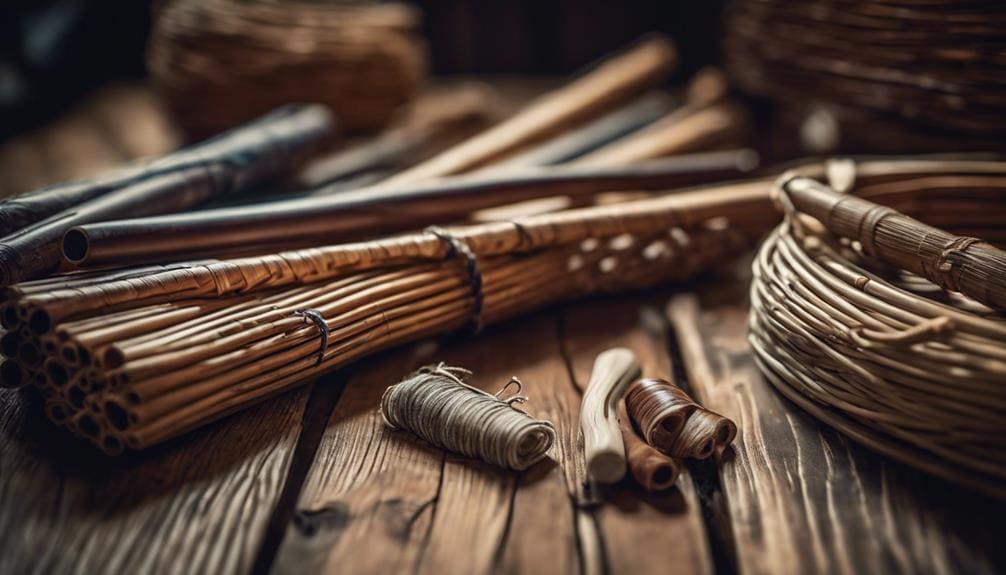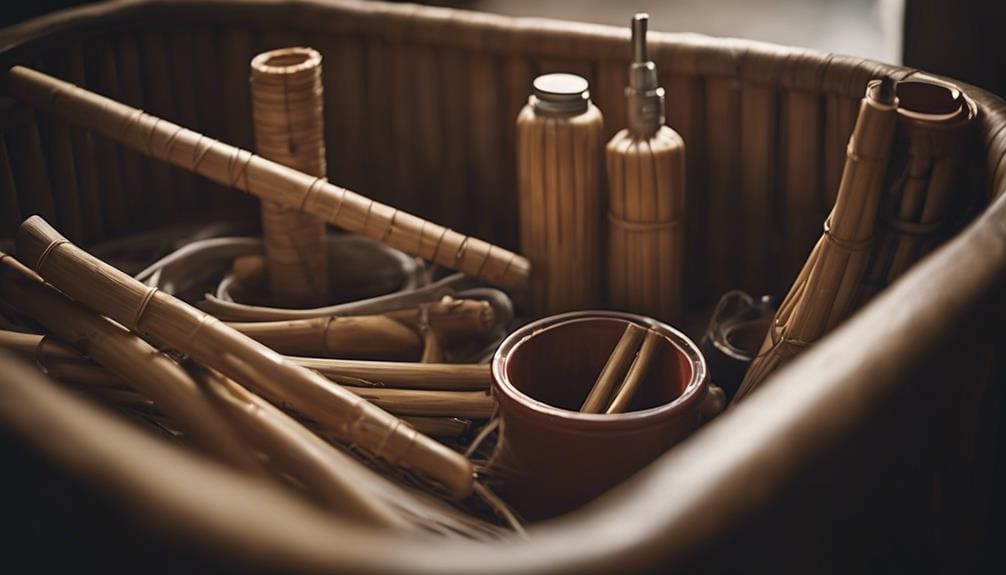Guide to Rattan Cane for Rush Weaving
As I was sorting through my workshop today, I stumbled upon an old rattan cane chair that reminded me of the elegance and durability that rush weaving brings to furniture. Over the years, I’ve honed my skills in this traditional craft, discovering the nuances of selecting and preparing the right materials to achieve the perfect weave.
I want to share some insights on the fundamentals of rush weaving with a rattan cane, touching upon the critical aspects of preparation and weaving techniques. Let’s explore how these elements come together to breathe new life into old furniture, and perhaps I’ll reveal a few professional secrets along the way.
Discover a comprehensive resource on crafting with rattan cane, focusing on traditional rush weaving techniques. Learn about selecting and preparing rattan for intricate designs suitable for beginners and experienced artisans alike.
Key Takeaways
- Rattan cane’s durability and flexibility make it ideal for various weaving styles and patterns in rush weaving.
- Proper preparation, including soaking and straightening, is crucial for consistent and durable weaving results.
- Mastery of weaving techniques, from basic strand placement to advanced patterns, is essential for creating visually appealing and structurally sound furniture.
- Regular maintenance, including dusting and moisturizing, is necessary to preserve rattan furniture’s natural beauty and longevity.
Understanding Rattan Cane
Delving into the world of rattan cane, I’ve found that this climbing palm, thriving in tropical climates, offers unparalleled durability and flexibility essential for furniture making and rush weaving. Its outer skin, once peeled, reveals a fibrous core that’s not just strong but remarkably adaptable to various weaving styles and patterns. This strength and versatility provide a stable base for furniture that can withstand significant pressure and weight, making it a favored material for traditional and contemporary pieces.
Rattan’s natural appearance lends an organic, warm touch to interiors, aligning with sustainability and eco-friendly living trends. This aspect of rattan benefits those of us seeking alternatives to synthetic materials that harm our environment. Its sustainability, a key trend in today’s design world, is compelling; as a rapidly renewable resource, rattan supports eco-conscious choices without sacrificing style or durability.
Exploring rattan in-depth, I’ve appreciated its contribution to design and sustainability. Its blend of function and beauty and its eco-friendly credentials position rattan as a material of choice for those passionate about crafting durable, stylish, and sustainable furniture.
Selecting Your Materials

Choosing the right rattan cane for your rush weaving project is a crucial step that demands attention to detail and an understanding of the material’s characteristics. My years of experience have taught me that the success of a project hinges on the quality of the materials selected.
Here’s what I focus on:
- Sourcing Options and Material Characteristics: I always explore various sourcing options to find rattan cane that is durable, flexible, and suitable for my projects. It’s vital to understand the material’s inherent characteristics, such as its natural strength and resilience, which make it ideal for rush weaving.
- Rod Selection: Choosing straight, smooth, and evenly sized rods is non-negotiable. This ensures consistent weaving results and affects the overall strength and aesthetic of the finished piece. The diameter of the rods significantly impacts the pattern and durability.
- Color Variations: I look for a uniform golden-brown color with minimal blemishes or cracks. Color consistency is key for a cohesive look in the final woven piece.
Ensuring the rattan cane is properly cured and processed is crucial. This step influences the material’s flexibility and longevity, setting the foundation for a successful rush weaving project.
Preparation Techniques

Having selected the right rattan cane for your project, the next step involves preparing the material to ensure optimal flexibility and strength for rush weaving. The process is intricate, requiring a delicate balance between maintaining the natural integrity of the rattan and enhancing its wearability.
I start by soaking the cane in warm water. This isn’t just a dip; it’s a thorough soaking to ensure the fibers are pliable, making them easier to work. As I handle the damp rattan, I gently bend and twist it, straightening each strand to perfection. This stage is critical; it sets the foundation for smooth, even weaving later.
| Preparation Step | Purpose |
|---|---|
| Soaking in warm water | Increases flexibility |
| Straightening while damp | Ensures even weaving |
| Trimming ends | Prevents snags and unevenness |
Keeping the cane moist throughout weaving is my little secret to preventing breakage. The ends, oh, the ends! They’re carefully secured, knotted, or stapled, adding those finishing touches that turn a piece from homemade to artisan.
Drying methods and dyeing options play here, allowing for creative expression through decorative accents. The result? A piece that’s not just made but crafted with intention and skill.
Weaving Fundamentals

With the rattan cane properly prepared, it’s crucial to master a few fundamental weaving techniques to ensure the furniture piece is both durable and aesthetically pleasing. Rush weaving with rattan cane isn’t just about intertwining strands; it’s an art that demands precision, patience, and a deep understanding of the material.
Here’s what I’ve learned through years of practice:
- Strand Placement: The foundation of any woven piece lies in how you place the strands. Each strand must be carefully positioned, ensuring they lie flat against each other without overlaps or gaps. This meticulous placement gives the furniture its uniform look and supportive structure.
- Tension Control: This is perhaps the most challenging yet rewarding aspect. Maintaining consistent tension throughout the weave is crucial. Too tight, and the cane might snap or warp the frame; too loose, and the seat won’t offer adequate support. It’s a delicate balance that comes with experience.
- Advanced Patterns: Once you’re comfortable with the basics, experimenting with advanced patterns can add a unique touch to your pieces. Patterns like herringbone or chevron enhance the visual appeal and test your skill in handling and manipulating the cane to achieve intricate designs.
Mastering these fundamentals has been a journey of constant learning and refinement.
Care and Maintenance

To ensure the longevity and beauty of your rattan cane creations, it’s imperative to adopt a rigorous care and maintenance routine. Through years of dedication to the craft of rush weaving, I’ve learned that a meticulous preservation approach pays dividends in the durability and appearance of rattan cane.
Firstly, I make it a habit to dust my rattan pieces gently and regularly using a soft cloth. This simple cleaning tip prevents dirt buildup that can mar the surface over time. I’ve found that avoiding direct sunlight and extreme temperatures is crucial; exposure can cause the rattan to dry out and become brittle, compromising its integrity.
I also apply a light furniture polish or wax coat to the surfaces. This preservation technique not only maintains the luster of the rattan but also offers a protective barrier against moisture. During my routine inspections, I look for any loose strands or damage, addressing them immediately to prevent further unraveling.
Lastly, storing rattan cane furniture in a cool, dry place safeguards it against warping or mold growth. Following these care and maintenance steps ensures my rush weaving projects remain pristine for years.
Frequently Asked Questions
How Long to Soak Rattan Before Weaving?
I usually soak my rattan for 24-48 hours, adjusting for its thickness. I’ve found that warmer water speeds things up, but it’s a delicate balance. It’s too long, and the fibers weaken—experience has been my guide.
Is There a Difference Between Rattan and Cane?
Yes, there’s a notable difference between rattan and cane. Rattan’s sustainability makes it a robust choice for furniture, while the cane’s flexibility lends itself beautifully to intricate weaving. I’ve found this distinction crucial in my projects.
How Do You Prepare a Cane for Weaving?
I’ve learned that preparing a cane for weaving is much like nurturing a garden. After selecting the perfect cane, I soak it, trim its edges, and keep it moist, ensuring my weaving techniques flourish beautifully.
What Is the Difference Between Natural Rush and Fiber Rush?
While offering a charmingly authentic look, I’ve found that natural rush demands more maintenance and is less durable than fiber rush, which is resilient against moisture and pests, making it easier for me to work with.
Conclusion
Venturing into the world of rush weaving with rattan cane feels akin to navigating a dense, uncharted forest. Each step, from selecting the perfect strand to mastering the intricate dance of weaving, mirrors the careful path one must tread in nature. Just as a single misstep in the wild can lead to a cascade of consequences, so too can a rushed or ill-considered choice in materials or technique mar the beauty of your creation. Yet, with patience and perseverance, the forest clears, revealing the exquisite craftsmanship of a perfectly woven chair seat, a testament to the journey undertaken and the skills honed along the way.







